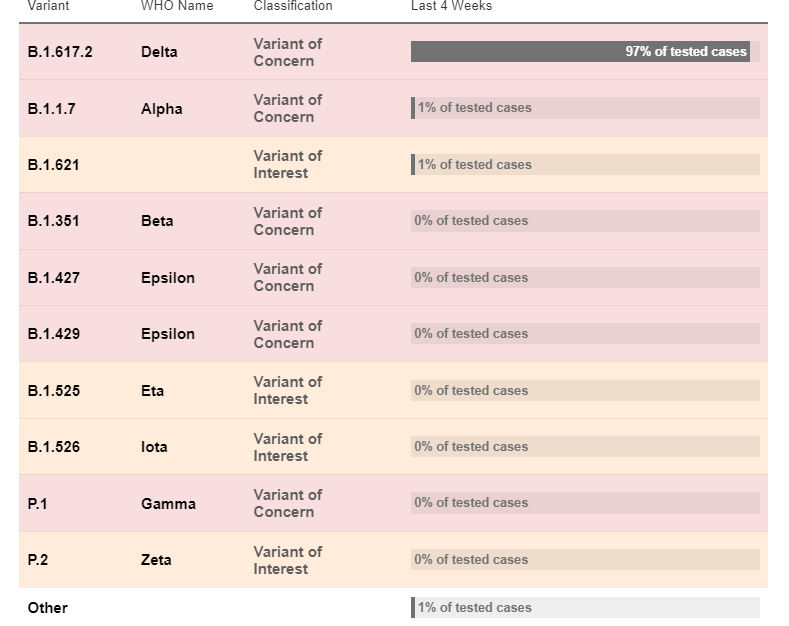What to Know
- The delta variant now accounts for 97% of all NYC samples tested in the last four weeks, though for the second straight week, transmission rates appear to be easing, new health data released Friday shows
- All five counties of NYC are still considered high transmission rate areas by the CDC, but hospitalization rates are declining in all five boroughs and transmission rates are down in three of the five
- The picture nationally is grimmer: the U.S. reported more than 2,000 daily COVID deaths (2,152) on Thursday for the first time since early March, marking a five-month high, according to NBC News data
The highly contagious delta variant continues to spread through New York City, now accounting for 97% of all positive samples tested — but for the second straight week, transmission rates are easing, a sign the latest wave may be turning the corner. The national picture, though, remains grimmer.
Transmission rates citywide are down 7% since last week, while the rolling daily case average is stable. The rolling hospitalization average is down 14% compared with the average for the four weeks prior, perhaps the strongest indication yet that the five boroughs may be emerging from the weeks-long delta-fueled spike.
Death rates are increasing slightly, according to the city’s latest data, but fatalities are a lagging indicator. As New Yorkers saw painfully in the spring of 2020 and to a lesser degree in the winter wave, before vaccinations rollout out, death rates continue to rise well after new daily cases level off.
The fact that hospitalizations are now declining is strong hope that recent increases in daily deaths will soon level off, too.

All five boroughs of New York City are still considered “high transmission” areas by the CDC, meaning they have at least 100 new daily cases per 100,000 residents, but CDC data shows hospitalizations rates for all five boroughs are down by double-digit percentage points over the last seven days.
Transmission rates are declining in three of the five boroughs. Over the last seven days, they’re down 16.7% in Manhattan, 8.3% in Queens and 13.2% in Staten Island, CDC shows. They’re up marginally in Brooklyn (0.23%) and more so in the Bronx (3.96%), viral spread likely linked to cases in low vaccination rate areas.
For New York City, the one-time epicenter of the pandemic, the delta surge may have peaked. Nationwide, it’s a different picture.
Dr. Jennifer Haythe, an assistant professor of Medicine in the Division of Cardiology at Columbia, answers your questions about COVID-19 and going back to school.
More than 92% of all U.S. counties fall into that “high transmission” rate category, an increase of 5.6% over the last seven days, according to the CDC. Another 4.16% of U.S. counties are considered “substantial transmission” rate areas. Under CDC guidance, that means universal indoor mask-wearing is still recommended for more than 96% of all counties in America regardless of vaccination status.
Lower vaccination rate states like Texas and Kentucky are still seeing COVID hospitalizations soar amid a rising toll on children.
On Thursday, the U.S. reported more than 2,000 daily COVID deaths for the first time since early March, according to NBC News data. At least 2,152 deaths were reported on Thursday. The last time the daily U.S. toll topped 2,000 was on March 5, with 2,235 lives lost due to COVID-19, data shows.
The U.S. is projected to see nearly 100,000 more COVID-19 deaths between now and Dec. 1, according to the nation’s most closely watched forecasting model. But health experts say that toll could be cut in half with some changes in behavior.
Vaccination rates as reported to the CDC have been steadily climbing since mid-July, when officials at all levels of government pleaded with the non-immunized to get vaccinated, citing the delta threat. That variant has been linked to more severe outcomes and deaths, especially among the unvaccinated, and accounts for nearly 99% of all samples tested by the CDC in the latest two-week period.
Vaccination efforts appear do appear to be working, also thanks in part to new measures increasingly closing daily life to the unvaccinated. The number of doses administered daily in New York doubled this month compared with July, but doctors say it will take several weeks for the latest spike in hospitalizations to level off.
New data released by New York City this week suggests vaccines are highly effective at preventing COVID infection and even more infective at preventing severe illness and death. A study put out by the Department of Health found .33% of new COVID cases in the city between Jan. 17 and Aug. 7 were breakthrough infections, meaning people who had been fully vaccinated contracted the virus, though that study considered months of data logged before the delta variant had a stranglehold on the city.
When NBC 4 New York asked Mayor Bill de Blasio if the data was too skewed to pre-delta conditions and therefore misleading, he said, “it is abundantly clear that unvaccinated people are in real danger and vaccinated people protected. We’ve got to keep showing people those facts.”
City health officials noted, “the most recent data show the crude case rate for unvaccinated people remains 3.1 times higher than it is for fully vaccinated people.”
The study also found unvaccinated people were 13 times more likely to be hospitalized with COVID than those who have been fully vaccinated.